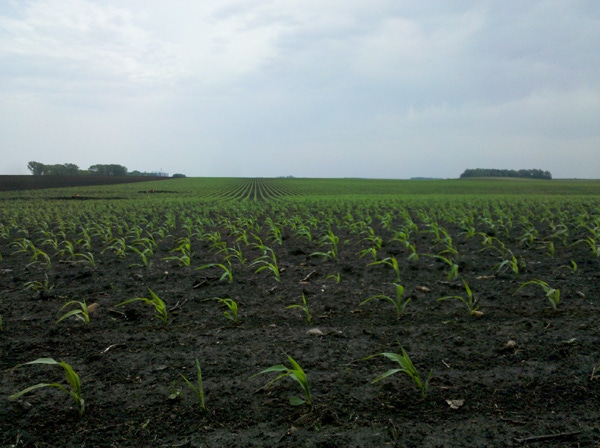December 10, 2012

March 2013 corn futures dropped below $5.50 in early May 2012 and were drifting lower when U.S. drought conditions turned prices higher starting in mid-June. The price of that contract peaked in early August, just short of the $8.50 mark. March 2013 soybean futures dropped below $11.50 in December 2011 before South American drought conditions and then U.S. drought conditions sent that contract above $17.25 by mid-September 2012.
Corn prices have declined by more than $1 since the late summer peak, while soybean prices have declined by more than $3. The general expectation has been that prices of both commodities would return to pre-drought levels as early as 2013 as consumption adjusted to the lower supplies and as production rebounded in both South America and the U.S. The futures market currently reflects expectations that corn prices will moderate substantially from current levels by the fall of 2013 as larger crops are harvested in Argentina and then in the U.S. December 2013 futures, for example, are priced $.95 below December 2012 futures. The soybean market expects prices to moderate from current levels by the summer of 2013 as a large South American crop is harvested. August 2013 futures prices are nearly $.60 lower than March 2013 prices. Further price reductions are expected into fall 2013 as a larger U.S. crop is harvested. November 2013 futures are about 85¢ below the price of August 2013 futures. Still, the prices of both commodities for delivery in the 2013-2014 marketing year are well above the levels prior to the drought of 2012.
Corn prices are being supported at relatively high levels due to a combination of production uncertainty and uncertainty about whether the rate of consumption has slowed sufficiently. The USDA's December Grain Stocks and Annual Crop Production reports, to be released on Jan. 11, will provide more clarity about the rate of domestic feed and residual use of corn and the availability of U.S. corn for the remainder of the current marketing year. Those reports are expected to reveal a high rate of feed and residual use of corn during the first quarter of the 2012-2013 marketing year and a smaller 2012 harvest than previously forecast.
Production uncertainty, on the other hand, will persist much longer. The potential size of the South American crops will be clearer by February. Current concerns are focused on the impact of extremely wet conditions in parts of Argentina. Prospects for the U.S crop will not be cleared up for several months. In the past five decades, extreme drought conditions in the U.S., like those experienced in 2012, have been followed by generally favorable growing conditions and yields near trend values. However, current dry soil moisture conditions in much of the U.S. and some recent forecasts that drought conditions could persist well into next year have raised concerns that such a rebound in yields may not occur in 2013.
Five or six years ago, the corn yield discussion was dominated by ideas that corn yields were increasing at an increasing rate due to new seed technology and that corn yields were "bullet proof." That discussion seemed to gloss over the impact of an extended period of very favorable weather. The pendulum has now swung in the other direction, with the current corn yield discussion dominated by the potential of an extended period of dry weather and sub-par yields. Only time will tell if the concerns are legitimate. For now, such concerns may motivate another year of large corn acreage. A return to a near-trend corn yield would then result in a very large crop in 2013. A large crop, along with a plateau in the amount of corn used in the production of ethanol, would result in a substantial build-up of stocks during the 2013-2014 marketing year and corn prices at or below the levels prior to the drought of 2012.
Soybean prices are being supported by a rapid pace of exports and domestic consumption. However, prospects are still in place for a record harvest in South America. Such a crop, in combination with a rebound in U.S production in 2013, would likely result in a build-up of stocks next year and prices at the level of late 2011.
There is a relatively high probability of large crops, increasing stocks, and lower corn and soybean prices in the 2013-2014 marketing year. Such a probability might warrant some aggressive pricing of next year's production. However, current tight supplies and production uncertainty are expected to keep prices relatively high in the early part of the new year. If that is the case, the spring price guarantees for crop revenue insurance could once again be at very high levels, offering protection from low prices that would result from large crops.
You May Also Like




